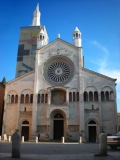Duomo di Modena
The Cathedral of Modena is one of the greatest masterpieces of the European Romanesque period made famous for its architecture under the direction of architect Lanfranco and for the notable sculptures of Wiligelmo.

In 1099 the Christian faith inspired the construction of many magnificent cathedrals throughout Europe. This artistic and religious fervor was present even in Modena where representatives of all social classes united in the decision to raise a new temple on the site of the ancient basilica which was home to the remains of Modena's Patron Saint, Bishop Geminiano. The admiration for Saint Geminiano, Modena's second bishop who lived between 312 and 397, was the basis for the construction of the Cathedral known as "domus clari Geminiani", home of the illustrious Geminiano and dedicated to the crowned Mother of God.
Construction began May 23 in 1099 under the direction of the illustrious artist and admired architect Lanfranco. The first stone was laid on June 9, 1099. Working along side Lanfranco was the great sculptor Wiligelmo who decorated the temple under construction between 1099 and 1106.  The plaque commemorating the foundation of the cathedral was carved by the same Wiligelmo with the figures of the antediluvian patriarch Enoch and the prophet Elijah on each side of the inscription and mounted on the cathedral's faà§ade. Another inscription outside on the central apse shows the Modena folk's gratitude to Lanfranco for the construction of the Cathedral.
The plaque commemorating the foundation of the cathedral was carved by the same Wiligelmo with the figures of the antediluvian patriarch Enoch and the prophet Elijah on each side of the inscription and mounted on the cathedral's faà§ade. Another inscription outside on the central apse shows the Modena folk's gratitude to Lanfranco for the construction of the Cathedral.
With the construction well in progress, the body of Saint Geminiano was moved to the crypt in the new basilica on April 30,1106. On the 7th and 8th of October that same year, Pope Pasquale II examined the remains of Saint Geminano and consecrated the altar in the presence of the Countess Matilde di Canossa as well as many cardinals, bishops, clergy and a large jubilant crowd.
Construction of the cathedral was completed 85 years after laying the first stone.
Pope Lucius III consecrated the cathedral on July 12, 1184. The event of that historic date was carved on the stone blocks located on the south side of the cathedral.
From the fourteenth to the seventeenth century, the interior underwent changes according to the tastes of the time. The systematic work of restoration began in 1852. From 1914 to 1921 the structure was restored to its original 13th century state.
In 1955 on the 850th anniversary of Saint Geminano's entombment, his remains were viewed for the third time and his crypt was restored to its original state.
Restoration of the cathedral's faà§ade and Wiligelmo's sculptures were performed between 1973 and 1984.
In 1984 for the 8th centennial (1184-1984) of the cathedral's consecration, the beautiful faà§ade showcased in all its splendor the art of Lanfranco, Wiligelmo and the Campionesi Masters. The sculptures by the Campionesi Masters on the parapet over the alter were renovated from 1986 to 1988.

In addition to being a sacred place of worship, the Cathedral of Modena brings together many works of art like the Romanesque sculptures of the Wiligelmo (outside) and the Campione Masters (inside) as well as the many other works which deserve to be seen and admired. It is not by chance that tourists from around the world come to visit "il Duomo di Modena" to admire its many works of art.
Il Duomo, the Ghirlandina (the bell tower) and Piazza Grande are listed with the UNESCO World Heritage Site as exceptional examples of the cultural tradition from the 12th century as well as being one of the best examples of architecture where religious and civic values are combined in a medieval Christian town.
 Fine Tastes of Modena
Fine Tastes of Modena






follow us on: